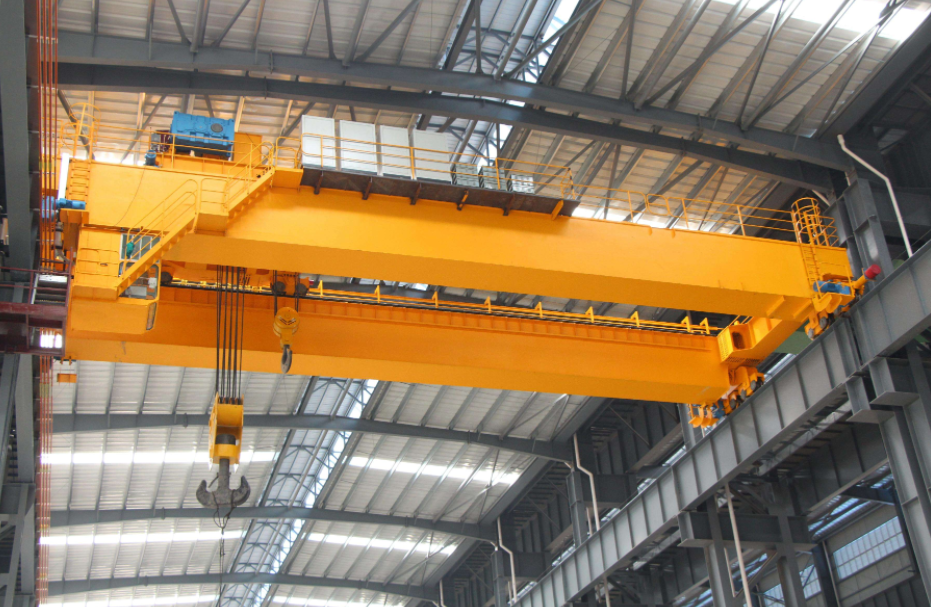Ensuring the Stability of a Double Girder 50 Ton Bridge Crane
- blog@ellsenbridgecrane.com
- Jun 19, 2024
- 4 min read
A double girder 50-ton bridge crane is a substantial piece of industrial equipment, typically used in heavy manufacturing environments, construction sites, and shipping yards. Its stability is paramount to ensure the safety of personnel, the integrity of the load, and the efficiency of operations. Several factors contribute to the stability of such a crane, including design considerations, installation practices, regular maintenance, and operational protocols. This article explores these aspects in detail to provide a comprehensive understanding of how to ensure the stability of a double girder 50-ton bridge crane.

Design Considerations
The stability of a double girder 50-ton bridge crane begins at the design stage. Several critical elements must be considered:
1. Structural Design
The crane's structural design must accommodate the load capacity and the operational environment. Double girders provide increased strength and stability, distributing the load evenly and reducing the risk of structural failure. The materials used, typically high-strength steel, must meet industry standards and be capable of withstanding the maximum load without deforming.
2. Load Distribution
Proper load distribution is crucial for stability. The design should ensure that the weight is evenly distributed across both girders. This can be achieved through precise engineering calculations and the use of advanced software to simulate load conditions and identify potential stress points.
3. Trolley and Hoist Design
The trolley and hoist mechanisms, which move along the girders, must be robust and well-engineered. The trolley should have a low center of gravity to reduce the risk of tipping, and the hoist must be capable of lifting and moving the load smoothly without causing oscillations that could destabilize the crane.
4. Safety Features
Incorporating safety features such as limit switches, overload sensors, and emergency brakes is essential. Limit switches prevent the crane from moving beyond its designated range, while overload sensors ensure that the crane does not lift more than its rated capacity. Emergency brakes can halt the crane immediately in case of a malfunction.
Installation Practices
Proper installation is critical to the stability of a double girder 50-ton bridge crane. The following practices should be adhered to:
1. Foundation and Supports
The foundation and support structures must be designed to bear the crane's weight and the loads it will lift. The foundation should be constructed from reinforced concrete and anchored securely to the ground. The supports, often in the form of columns or beams, must be aligned perfectly to ensure that the crane operates smoothly along its tracks.
2. Alignment and Calibration
Precise alignment and calibration during installation are vital. Misalignment can cause uneven load distribution and increased wear and tear on the crane components, leading to instability. Advanced laser alignment tools and techniques should be used to ensure that the crane is perfectly aligned.
3. Rail Installation
The rails on which the crane travels must be installed with high precision. Any deviation or unevenness can cause the crane to derail or operate unsmoothly. The rails should be regularly inspected and maintained to ensure they remain in optimal condition.
Regular Maintenance
Ongoing maintenance is essential to maintain the stability and safety of a double girder 50-ton bridge crane. A comprehensive maintenance program should include:
1. Routine Inspections
Regular inspections should be conducted to identify and address potential issues before they become serious problems. Inspections should cover all components of the crane, including the girders, trolley, hoist, rails, and safety features.
2. Lubrication
Proper lubrication of moving parts reduces friction and wear, ensuring smooth operation and extending the lifespan of the crane components. A consistent lubrication schedule should be followed, using the appropriate lubricants recommended by the manufacturer.
3. Component Replacement
Worn or damaged components should be replaced promptly. This includes cables, bearings, gears, and electrical systems. Using genuine replacement parts and following the manufacturer’s guidelines is crucial for maintaining the crane’s integrity and stability.
4. Load Testing
Regular load testing should be conducted to verify that the crane can safely lift and move its rated capacity. This testing helps ensure that all systems are functioning correctly and that the crane can handle the operational demands placed on it.
Operational Protocols
Safe and efficient operation of a double girder 50-ton bridge crane also contributes to its stability. Operators should be well-trained and adhere to established protocols:
1. Operator Training
Operators must receive thorough training on the crane’s operation, including its controls, safety features, and emergency procedures. They should also be familiar with load calculations and the importance of proper load distribution.
2. Safe Lifting Practices
Operators should follow safe lifting practices, such as ensuring that the load is securely attached and balanced before lifting, avoiding sudden movements, and not exceeding the crane’s rated capacity. Additionally, they should be vigilant for any signs of malfunction or instability and report them immediately.
3. Environmental Considerations
Environmental factors such as wind, temperature, and lighting can affect the stability of the crane. Operators should be aware of these conditions and adjust their operations accordingly. For example, high winds can cause swinging loads, and poor visibility can increase the risk of accidents.
4. Emergency Procedures
Having clear emergency procedures in place is essential. Operators should know how to respond to various emergencies, such as mechanical failures, power outages, or accidents. Regular drills and training can help ensure that they are prepared to act quickly and effectively.
Conclusion
Ensuring the stability of a double girder 50-ton bridge crane involves a multifaceted approach that includes careful design, precise installation, regular maintenance, and strict adherence to operational protocols. By addressing each of these aspects comprehensively, operators can maximize the safety, efficiency, and longevity of these critical pieces of industrial equipment. Ultimately, a stable and well-maintained bridge crane not only enhances operational productivity but also safeguards the well-being of personnel and the integrity of the loads being handled.








Comments